Awareness - Life - Form
GA 89
Planetary Evolution XI
9 November 1904, Berlin
We often talk about principles as if they were of the same kind and only differed in degree. Yet if we want to understand how things are connected, we need to get to know the principles themselves in their nature.
We need to distinguish three things in the world; three kinds of effects. Only things that take effect can be considered by a perceptive entity, and we therefore focus our attention on the effects. There are therefore three ways in which something may take effect—first, actually in the spirit; secondly in the soul, thirdly at the physical level. Effects in the spirit, anything that can in some way take effect in spirit, is called budhi; anything that can take effect at soul level is called kama; everything that can have a physical effect is called prana. Budhi, kama and prana are the three ways of taking effect. They are of the same kind but at different levels.
Now we have to realize that effects would always be fluid, indefinite, if they did not define themselves. If kama is to happen in a particular way, for instance, it must set itself limits. Budhi, kama and prana must therefore set themselves limits if they are to be defined influences or effects. In the theosophical literature these boundaries are called ‘sharira’, meaning ‘vessel, shell, sheath’. If budhi sets itself a boundary, this is called ‘karana sharira’; if kama does, it is ‘linga sharira’, and with prana it is ‘sthula sharira’. These sharira are thus the limits, the outer forms, which the three kinds of effects set for themselves. Now the following may happen (Fig. 10, starting from below).
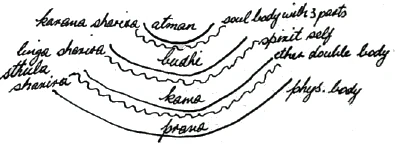
First of all we have prana in action; then prana sets itself a limit on the outside—sthula sharira. Prana thus sets itself a boundary in one direction but remains billowing and open in the other. Prana is now joined by kama, setting itself a boundary here—linga sharira. Then prana is no longer billowing and open on this side either, for kama with its boundary has pushed its way in. Kama in turn remains open on the other side. Then budhi comes and limits itself off from kama, and you get karana sharira. The three principles thus have intermediate layers. If this is a spirit, a self-awareness must also live in these three principles and their interfaces—this is known as ‘atman’.
The human being consists of the three principles, the interfaces and self-awareness or atman. Each may have its own subdivisions. If we take it like this, we have the composition of the human being as such.
Here, in the human being (Fig. 10), the physical body is the outer shell, and atman rests inside. The arrangement can of course also be very different. [For the planetary spirit,] the situation is, for example, that prana shows itself initially as active, setting itself a limit, in an inward direction. (Fig. 11)
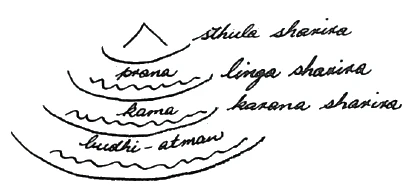
Prana is then limited on the inside by sthula sharira, kama by linga sharira, and budhi by karana sharira. We would thus have an entity where atman was on the outside, then budhi, then kama and last of all prana. Atman would then appear as wholly expanded in the periphery [an orb] and sthula sharira would be a point at the centre. (Fig. 12)
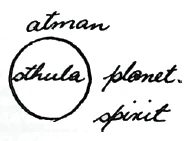
Such a spirit would be a dhyan chohan, a planetary spirit that must present in a way which is the reverse of the human way. In the human being, sthula sharira is on the outside, in dhyan chohans atman; then comes budhi, and so on.
We can get a clear idea of this if we take the following example. If we close our eyes, it is dark for the time being; once we open them again, we see the light. We only see the light, however, because we have an inner feeling for it and are therefore able to receive it. It must first be there, however, if we are to receive it. And just as we have to be there to sense the light, so there must be an entity out there which reveals light. We are light receivers; out there must be light givers, light revealers. And just as we are only able to sense light because we have kama, the astral body, in us, so a planetary spirit must have a kama that lets light shine out. Kama is thus active towards the centre here, and in the radius of the circle there. (Fig. 13)
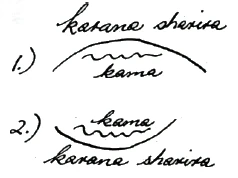
The circle which is convex towards the top is for us, for our sentience, for the one which receives, the principle moving towards the giver. The circle which is convex towards the bottom is the kama of the dhyanic spirit. The kama of revelation thus acts downwards—karana sharira. Whereas the human being has a kama that seeks to move towards the centre, so the planetary spirit has a kama that seeks to move outwards, to the periphery, revealing light, whilst the kama of the human being receives light. Two kinds of spirits, natures that complement one another, always go together. A spirit must have the desire—receiving; another must be able to give—giving. Human desirous kama presupposes that there is a giving kama, the kama of love.
Human budhi mediates insight. Such insight as we gain into things comes through our budhi. The planetary spirit must thus be a giver of thoughts, and human budhi a receiver. The planetary spirit thus acts in entirely the opposite way, complementing the human spirit.
Every single thing in the world exists only in the context of the whole; it is part of the whole. As a part it belongs to the whole planetary Earth spirit. Thus this table here consists of matter, which makes it an object we encounter in space; secondly it has energy, for it offers resistance, otherwise it would not exist for us; thirdly this energy does not come to expression at random but according to specific laws (natural laws).
What is energy? What is it that makes life possible in us? It is an energy which takes things in, maintaining life. Human vital energy serves to hold together the matter which is in the human being. Because of this, the matter and its energy in the human being is directed inwards, building the human being up from inside. Without this, we could not be perceived as living human beings. The table on the other hand has matter which is directed outwards, and this functions according to law. Matter as such cannot be perceived, only its properties and qualities such as colours, sounds, and so on. Matter itself is completely beyond sensory perception. A prana in matter withdraws completely from sensory perception but gives itself in order to reveal itself. We also have insight into the law which lies in matter, and the thought which comes to expression in it.
Budhi comes to outer expression in the natural world. Every body which gives outward expression to the planetary spirit is continually radiating outwards; its budhi is thus directed outwards. It becomes light which the senses perceive. Budhi lies in the properties and qualities of things, in the aspect which is on the outside. The law must reveal itself through karana sharira. Manas revealed is law. In being luminous, a body sends us budhi. The thought, expressing spirit, through which it sends us budhi, is karana sharira. The planetary spirit keeps kama to itself, withdrawing it from sensory perception. Its matter ... [Marie Steiner-von Sivers’ notes indicate a gap here.] On the other hand it reveals the cosmic thoughts which human beings must fathom deep down inside. The principle which the planetary spirit revealed wholly on the surface is its budhi. In the Bible, it says that the planetary spirit first of all revealed itself as light. The spirit thus reveals budhi qualities (light) at the first level. Budhi qualities (light) are revealed by the spirit at the first level. These ancient sacred teachings of the polarity between human being and planetary spirit are brought out most beautifully in esoteric Christian teaching. In cabbalistic terms the budhi qualities which come to revelation are called ‘powers’. It is thus the powers of light and darkness which revealed themselves first. Once again we can take Genesis literally.
The spirit thus reveals budhi qualities on the first level. On the second it reveals its karana sharira; it orders things according to laws. Something which is convex in the macrocosm is thus concave in the microcosm. Something which the human being perceives last, comes first in the macrocosm; the microcosm finally comes to perceive and understand the sentient experience in the macrocosm.
The question arises if there is a transitional stage between the two—between human being and planetary spirit. Think of an entity with one conscious awareness. That is the human being. He has different parts, but these share a common awareness. (Struggle between patricians and plebeians.)77Plebeians could not be priests or hold political office. From the 4th century BC onwards, the privileges of patricians grew less and less, and in 287 the plebeians were given equal rights politically. We might show it more or less like this (Fig. 14).

Individual parts all radiate towards the common awareness. If we take the latter to be energy, and the parts, too, we can say that the common awareness is predominant, influencing all the others. Now think of numerous entities functioning in this way (Fig. 15) 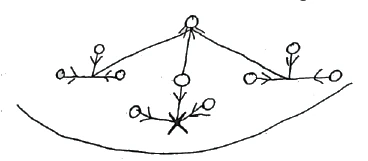
Each has its own existence. Through [the common ideal] it can connect its own with those of others. The different conscious minds create a common focus; they seek to gain a specific common ideal. This then lives in the different conscious minds as a common spiritual ideal. If they reach the point where their spiritual ideal is of greater value to them than they themselves, they will be drawn to it just as before they drew the parts of their conscious awareness to themselves. Where before they had been the focus or centre for those different spheres, the common ideal will then be the central focus for the large sphere. Individual entities then become parts of a common entity, giving up their separate existences and living in the common ideal. They cease to be centre and give themselves a common centre. A brotherhood lodge then develops from individual people. If the common ideal is so powerful that it draws all the individual conscious minds to it, these people make up a body that has a soul of a higher kind. A brotherhood lodge then develops with a perfectly communal spirit. This is a new entity. The soul could never have come down into the human being if he had not become a house for it with different parts. It is never possible for a higher principle to come down unless individual minds become vital parts, the form for a higher kind of house, so that the common awareness may come to expression in it.
This gives us the transition. Another centre is created. Human development is an inversion, the reversal of all principles. As human beings express themselves in seven ways, we get not one but seven centres. These will be the seven elohim, the pitris for the next planet.
Man thus progresses from a spirit which takes in the surrounding world to a spirit which reveals itself. The two completely opposite natures—human being and elohim or dhyan—are merely forms of one essential nature. At a future time, the human being will no longer be as he is now; he will be a dhyan chohanic spirit. In esoteric terms this is called the ‘secret of man becoming god’.
When individual conscious minds all turn to one centre, with everything outside becoming atman, there will be just a single core of sthula sharira inside, which is unity at its highest level.
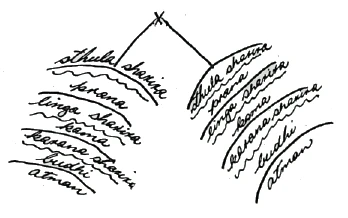
Such oneness cannot be achieved on Earth; it needed seven sublime spirits to create it. This, then, is the Logos, with atman in the periphery. In the cabbala, the ‘realm’, union, crowns all. This is also the principle on which the Church is founded, with all human beings having part in one conscious awareness. The law of form is birth and death. The law of life is rebirth. The law of the spirit is karma. Life goes through birth and death, appearing in new forms all the time. Form is transient by nature, life repeats itself, the spirit does not perish, it is eternal.

